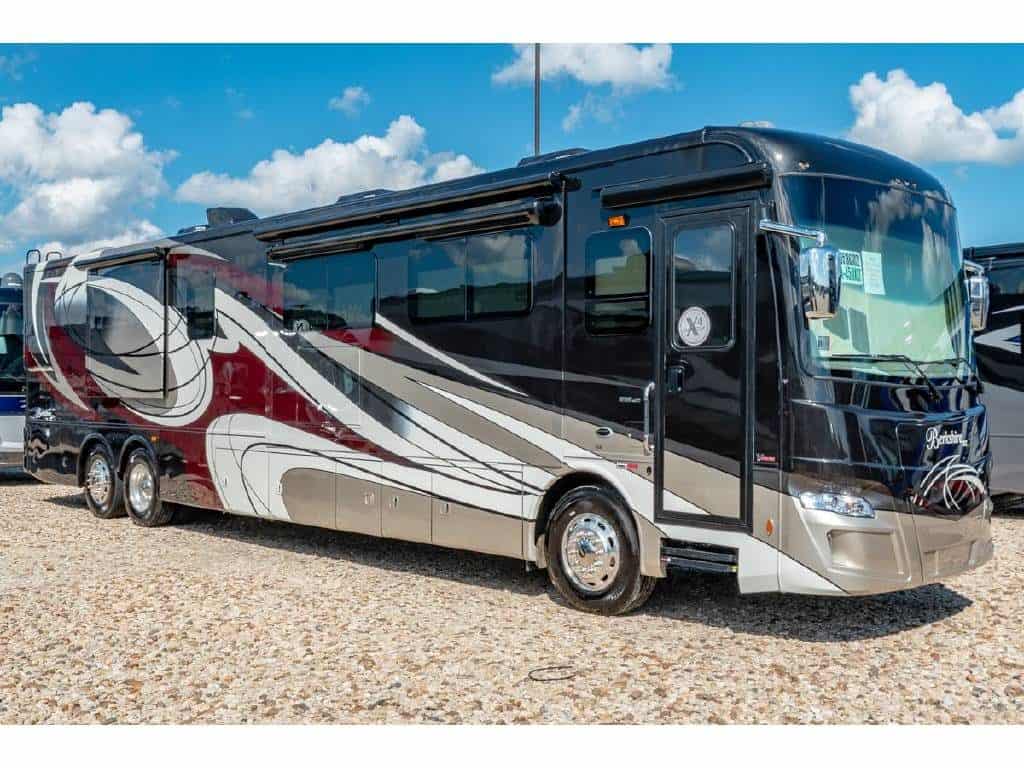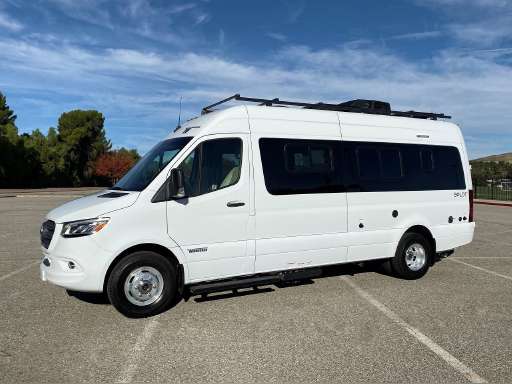Last Updated on March 26, 2022 by Ted Mosby
RVs are big bulky motorhomes that weigh a lot, and they have their own engine that powers them to move.
RVs come in different classes, which can vary their sizes, shapes, features, and a lot of other interesting things. Using an RV for long trips can leave you wondering about gas mileage sometimes.
Different engines can have different efficiency based on their performance and engine types, such as gas or diesel engine.
Knowing your RV gas mileage is really significant on the grounds that you can sort out what’s in store and how much expense it will cost you. When you know, you can sort out some way to further develop the mileage your vehicle is getting.
Remember that an RV’s gas mileage relies upon many variables, and in general, isn’t pretty much as productive as traveler vehicles.
Here is a short answer for what gas mileage your average RV may give.
- For a Class A RV, it is normal to get a 7 – 13 miles range a gallon.
- For a Class B RV, it is normal to get an 18 – 25 miles range a gallon.
- For a Class C RV, it is normal to get a 14 – 18 miles range a gallon.
This gas mileage of the RV can depend upon different factors, and it can change greatly for various reasons which may affect the efficiency.
- The heavier and bigger the RV is, the less will be the gas mileage for the most part.
- Gas mileage can also fluctuate contingent upon shape.
- Different sizes influence efficiency.
- A diesel-controlled RV can additionally influence your mileage.
Motorhome Gas Mileage Chart
| Motorhome Type | Gas Tank Size | Miles Per Gallon (MPG) | Distance on a Single Tank |
| Class A | 80 to 150 Gallons | 7 to 13 MPG | 560 to 1,950 Miles |
| Class B | 25 Gallons | 18 to 25 MPG | 450 to 625 Miles |
| Class C | 24 to 55 Gallons | 14 to 18 MPG | 336 to 990 Miles |
Separating tank size by class gives us a more clear image of what we can anticipate. In any case, there is a difference for each one of them. Let’s see each category in detail.
Class A Motorhome Gas Mileage
Class A Motorhome has a massive casing that sits upon a gigantic undercarriage and an amazing, powerful motor that pulls the motorhome from one state to another. It’s a vehicle with vast space for you and your family, which has its size and weight. Without a doubt, Class As have the biggest tanks.
Camping Gear SALE!
We have teamed up with Ape Survival to give you a huge 25% off EVERYTHING on their store! They have camping gear, hiking gear, survival gear and much more, all at 25% off when you click the link below.
SHOP NOWSadly, they also have the most exceedingly awful gas mileage of every one of the three RV types.
In addition to the fact that they are enormous, they have the streamlined floorplans of a square of wood. One more colossal factor in the dreadful gas mileage of this RV is the gigantic weight. Class A RVs on normal weigh 30,000 pounds or more which is what might be compared to about 17.5 tons.
This is a ton of vehicle weight that the motor needs to pull, bringing about a load of work that the motor needs to do to pull the vehicle, which gobbles up your fuel.
The more work the motor needs to do, the more awful the gas mileage will be. Since we are examining fuel tanks and mileage, you should take note that many Class A RVs don’t have a good fuel mileage, but they give better performance on diesel fuel.
Diesel is frequently more costly than gas, so consider that for any expense estimations you may be making at present.
While it very well may be setting you back additional in fuel, it eventually saves you a lot of cash. Diesel motors are broadly strong, and the RVs that use these engines hold their worth all-around well.
Here are some of the Best Class A Motorhome and their gas mileage,
| Name | Miles Per Gallon (MPG) |
| Jayco Precept | 7.5 – 8 MPG |
| Coachmen Mirada | 6 MPG |
| Winnebago Vista | 7 – 9 MPG |
| Forest River FR3 | 8 MPG |
| Tiffin Phaeton | 8.7 – 10 MPG |
| Newmar Dutch Star | 8 – 11 MPG |
| Holiday Rambler Navigator | 7.4 – 8.5 MPG |
| Fleetwood Discovery 39G | 7.5 – 9 MPG |
| Newmar Dutch Star | 8 – 11 MPG |
Class B Motorhome Gas Mileage
Class B RVs are small and much lightweight than Class A RVs, which help them to give better gas mileage due to reduced size and weight. This is a direct result of the shape and weight of the vehicle. Class B Manufacturers want to make lightweight vehicles because it is one of the important USPs.
Class B RVs have an extremely smooth form and the front finish of the vehicle in a skewed shape for getting air-cutting progress to the top of the vehicle.
There are some features that you may miss with Class B RVs as they are smaller, but they improve gas mileage. Without a problem, it can travel a lot smoother than Class A RV and a Class C RV.
Camping Gear SALE!
We have teamed up with Ape Survival to give you a huge 25% off EVERYTHING on their store! They have camping gear, hiking gear, survival gear and much more, all at 25% off when you click the link below.
SHOP NOWThis assists with furnishing Class B RVs with better mileage due to not struggling to push through restricting powers.
Another factor that plays into the great gas mileage of this type of RV is the weight. This is the lightest kind of RV you can get.
Weight is a tremendous factor in deciding how much the motor should attempt to power and pull the vehicle, which factors into how positive or negative of gas mileage a vehicle will get.
Here are some of the Best Class B Motorhome and their gas mileage,
| Name | Miles Per Gallon (MPG) |
| Winnebago Revel | 18 – 22 MPG |
| Storyteller Overland | 18 MPG |
| Roadtrek Zion SRT | 17 MPG |
| Embassy RV Sportsman | 19 MPG |
| Hymer Aktiv Dodge Promaster | 13 – 19 MPG |
| Winnebago Travato | 18 – 22 MPG |
| Airstream Interstate | 18 – 21 MPG |
| Coach House Arriva | 19 – 24 MPG |
| Coachmen Galleria | 18 – 22 MPG |
Class C Motorhome Gas Mileage
The Class C RVs are also big in size than Class B RVs, and they have good gas mileage, unlike Class A motorhomes.
This is because of their weight as Class C RVs are comparative in the form to Class B, yet they have a couple of contrasts that factor into why Class C gives gas mileage.
Class C RVs have a lovely smooth, smooth front like Class B does, yet Class C RVs have a bunk in the trailer segment that looms over the cab of the cockpit in the vehicle. This shade makes a check for the progression of wind off of the vehicle, similar to the Class B RV has.
The Class C RV additionally gauges a bit in excess of Class B does.
This is because of the additional trailer space, from the overhanging piece of the trailer, and on the grounds that Class C RVs are by and large greater than Class B RVs are. Like with Class A RV and Class B, this weight conveyance and wind stream is the thing that makes the Class C RV second in the positioning for best mileage.
The normal mileage that this kind of RV gets is around 14 to 18 miles for every gallon.
Here are some of the Best Class C Motorhome and their gas mileage,
| Name | Miles Per Gallon (MPG) |
| Winnebago View | 16 – 18 MPG |
| Winnebago Minnie Winnie | 8 – 10 MPG |
| Coachmen Freelander | 15 – 18 MPG |
| Jayco Melbourne | 14 – 15 MPG |
| Jayco Greyhawk Prestige | 10 MPG |
| Thor Motor Coach Outlaw | 9.5 MPG |
| Thor MotorCoach Quantum Sprinter | 16 – 18 MPG |
| Coachmen Leprechaun | 8.2 – 10 MPG |
| Jayco Greyhawk | 10 MPG |
How to Improve RV Gas Mileage?
You can improve your RV’s gas mileage by following some easy tips and making few changes to your vehicle to get good mileage as well as fuel consumption too. The little changes in mileage greatly affect your general financial plan.
Work on a solitary digit of your RV’s MPG, and your 100-gallon fuel tank will take you additional miles.
1. Drive at Average Speed
Driving at an average gives you more miles to the gallon. Usually, 50 MPH to 60 MPH is the average speed that gives the best miles to the gallon, and it is ideal for eco-friendliness. Anything higher than that experiences an excessive amount of air opposition, and your gas mileage drops drastically.
The normal gas-saving that you will get is 10 to 15 percent. In case that is on a 100-gallon tank at 10 MPG, that will get you one more 100 to 150 miles. The enhancements are a lot more noteworthy for more eco-friendly vehicles.
2. Less Acceleration and Cruise Control
Using less power will greatly increase the mileage of your vehicle because putting your foot down will suck more fuel for the engine and your mileage vacates the premises. In case that you speed up rapidly and regularly, it drops significantly. It can really drop down the mileage of your RV.
3. Less Weight
Having less weight in your RV can greatly increase mileage. When there is a load on your RV, the engine has to use more power, and it consumes more fuel under power. This causes it to drop mileage drastically. On that note, if there’s anything you can do about it, don’t top off your water tank until you are at your objective. Water tank weighs around 8.3 pounds per gallon.
Conclusion
This was a discussion about the RV Gas Mileage Chart, where we also shared each of the RV class mileage and its performance for long trips.
FAQ
How many miles per gallon can a 25 foot RV get?
The normal mileage that this kind of RV gets is around 18 to 25 miles for every gallon. This is, in reality, better compared to some bigger diesel trucks even get.
What is the normal mileage for an RV?
The business for a significant distance driven in your RV every year is around 5,000 miles. We’ve seen a couple of full-clocks drive up to 9,000 per year; however, it’s uncommon. We’ll expect that 5,000 is normal. Makers guarantee that their RVs go anyplace from 10-20 miles for every gallon.
What is the best mileage for an RV?
While there are special cases for each class, on normal Class B RVs, or Camper Vans, are the most eco-friendly RVs with industry normal of 18-25 miles for every gallon. Class C RVs are next with a normal of 14-18 mpg, with Class A RVs coming in third at 7-13 mpg.
How long do RV engines last?
On average, a normal engine may last about 200,000 miles. Diesel engines have a longer life and they can last about 300,000 miles.
Table of Contents



